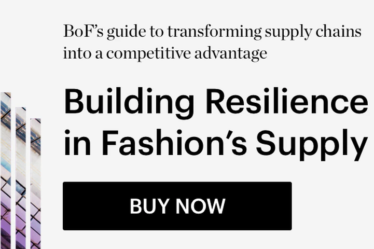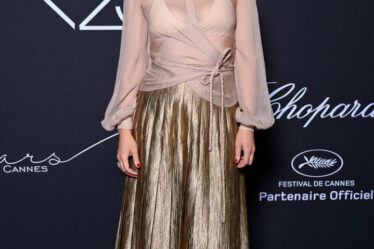This October, Oud Fashion Talks (OFT) returned for its third year to host regional and international fashion professionals and press for networking dinners, an exhibition of regional design talent and a series of panel talks and workshops at the Abdullah Al Salem Cultural Centre, examining the fashion, retail and beauty landscapes in Kuwait and the Middle East.
The Gulf Cooperation Council, or the GCC — a region that consists of Bahrain, Kuwait, Oman, Qatar, Kingdom of Saudi Arabia and United Arab Emirates — is today considered a bright spot for the global fashion industry. BoF and McKinsey’s survey of fashion executives for The State of Fashion 2024 report revealed the Middle East was considered the most promising region in 2024 vs 2023, with 51 percent net intent.
“[The region] is a shining candle in the industry generally, because of the resilience and growing sophistication of the GCC customer,” said Khalid Al Tayer, the CEO of regional luxury e-commerce giant Ounass, owned by Al Tayer Group, in his first public interview with The Business of Fashion’s founder and CEO Imran Amed.
“The customer here is creating their own fashion narrative and that’s a sign of maturity. I think the best demonstration of that is in Kuwait, which is the most forward resident of the Gulf Nationals in terms of the fashion narrative,” he added.
Oud Fashion Talks is the brainchild of Zainab ALabdulrazzaq, founder of fashion and beauty publication 3oud.com, who launched the event in 2022 with the ambition of challenging perceptions of Kuwait and the wider GCC as a purely consumer-facing market. Rather, she wanted to shine a spotlight on the homegrown businesses and talent flourishing in the region and capturing the interest and discretionary spend of the sought-after local consumer.
“For the longest time, we were only considered consumers,” ALabdulrazzaq told BoF at the event’s concluding dinner. But now, emerging careers in creative sectors like fashion and beauty are “taken more seriously” in Kuwait,” from entrepreneurs and designers to photographers and content creators. “This change shows that we can and have to open new job opportunities in the economy. For us, it’s now very important — the business behind the fashion.”
She added that she has a clearer vision for OFT now that the event is more established after its first 3 years, but also because they have a “clearer direction for the whole country”.
Indeed, Kuwait’s Vision 2035 — like many of the government-level plans for the GCC’s major economies — has set out strategic developmental goals to increase local productivity and development of non-oil economic sectors. The New Kuwait vision details “creative human capital” as a core pillar to that plan.
OFT is now a leading example of the emerging industry events growing in global recognition in the region, and spotlighting local talent and business on the international stage. Indeed, many OFT attendees went on to Saudi Arabia afterwards to attend Riyadh Fashion Week.
Now, BoF condenses learnings from the regional executives and talent on stage at OFT, representing established and emerging businesses spearheading change in a rapidly evolving industry in Kuwait and the wider GCC.
Driving Transformation in the GCC’s Luxury Market
In his first-ever public interview, Khalid Al Tayer joined BoF’s Imran Amed to open the panel talks. Al Tayer is the managing director of Al Tayer Insignia, the retail arm of Al Tayer Group — one of the largest luxury retailers in the Middle East. The company operates nearly 200 stores across the GCC, holding joint ventures with brands like Bottega Veneta, Bulgari, Ermenegildo Zegna, Gucci, Prada and Saint Laurent, and is the exclusive licensee for Bloomingdale’s and Harvey Nichols in Kuwait and the UAE.
Khalid Al Tayer is also CEO of Ounass — a home-grown luxury e-commerce platform that launched in 2016 with 200 brands. Today, the site stocks over 1300 regional and international labels across the six GCC countries, recently working with the likes of Skims, Kith and Essentials Fear of God to enter the region and better meet consumer expectations.
“The brands that have taken this customer as a very important customer and respects them are seeing benefits. The ones that approach this customer as, ‘they’re just going to buy what we make and we’re going to do […] a good enough job because we’re busy somewhere else,’ are not benefiting from this customer,” said Al Tayer.
“Respect the Middle Eastern customer. And what does that mean? You’re seeing brands opening stores and the artwork going into these global flagship stores is in collaboration with local artists. I think that speaks to something. Creating collections with regional talent, capsule collections, that says something. Having not lip service type of activations but having important, culturally thoughtful activations in this market.”
Ounass exclusively provides a 2-hour delivery service in Dubai and 3-hour delivery in Riyadh while a 4-hour delivery service is soon to launch in Kuwait City. In order to deliver on that speed of service, Ounass has built out an infrastructural behemoth in just 8 years.
With Ounass, we said we’re going to put blinkers on and focus on the Gulf. That’s it — we’re not going to be distracted with the world.
— Khalid Al Tayer
“Eighty percent of all orders in the Gulf we do with our [delivery] fleet — we built an Amazon for luxury,” Al Tayer said. “So Ounass is more of a logistics company, as much as it is a technology company, and we started with two cars and a shopping cart.”
“The Middle East is always a late but a fast adopter […] And so what you see is the pace of growth of the online channel in the Gulf is amongst the fastest on a geographic level worldwide on an e-comm basis,” he added.
While many of these companies have struggled to survive the e-commerce and luxury slowdown, Ounass has emerged with double digit growth in an oversubscribed sector. Al Tayer describes it as a “David and Goliath game”, starting small and remaining hyper-focused on localisation and a high level of service.
“With Ounass, we said we’re going to put blinkers on and focus on the Gulf. That’s it — we’re not going to be distracted with the world, we don’t care about solving for even our local customers when they go to Europe and ship to them. We are just going to focus on the Gulf.”
The approach is paying off, as the company emerges as a leader in the Middle East and Africa’s luxury goods market, which Mordor Intelligence estimates to have a market size of US$14.05 billion in 2024. It is expected to reach more than US$19 billion by 2029, growing at a CAGR of 6.23 percent.
To close out the session, Al Tayer offered his advice in succeeding in the region. He returned to the idea of having a “fanatical focus”, suggesting companies and brands stick to “what you’re doing and get it right and get the data and get the views of what’s working. The customer is going to tell you. You may have a vision that may be a little bit ahead of its time — stick with it. Get the right data, evolve. […] We have an idea to test: if it’s right, we’ll go with it; if it’s wrong, we’ll kill it. So have the ability to test and learn and move.”
The Power of Digital Influence
Luxury brand strategy expert Morin Oluwole, formerly global luxury director at Meta, moderated a conversation between Dubai-based fashion influencer and eyewear brand owner Karen Wazen, Kuwaiti influencer and beauty brand owner Noha Nabil, and strategic partner manager for global partnerships at Meta, Joana Jamil.
The panel opened on a discussion around the need for content creators today to remain nimble and adapt to evolving platforms and communities. Wazen, who began her career online in 2016 and launched her namesake eyewear brand in 2018, said community has played a significant role in her business’ evolution.
“The foundation of both my personal brand and my fashion brand is my community. It’s an ongoing journey and it is full of changes. So you are constantly having to adapt to those changes to grow together with this community, to keep telling our stories,” Wazen said.
“It’s very easy to sit in your comfort zone or sit with what used to work for you. So I think what’s super important, whether it’s from a small business perspective or even for us as creators, is to constantly be comfortable with change and with adapting to those changes,” she added.
For Nabil, her online community has dictated the direction of her eponymous beauty business, which she launched in 2020. She relies on their engagement and feedback to drive product success: “Instant customers’ and consumers’ feedback […] was not available or accessible 10 years ago. When I want to launch a product, it’s so easy for me now to create a survey or ask my audience or followers through any social media platforms — what do you prefer? What do you want next? What do you like and don’t like at the end of this?”
What’s super important, whether it’s from a small business perspective or even for us as creators, is to constantly be comfortable with change and with adapting to those changes.
— Karen Wazen
As content creators moving into entrepreneurial ventures, Jamil commented on the unique challenges that this offers, as brands start and then they grow the community. “Content creators, they have the community, then they build the brand. So when you have that approach, that community is expecting a lot from you. They’re expecting consistency. They’re expecting that you’re true to them and you’re not just trying to sell them stuff.”
Jamil, who later hosted a workshop on best practices for using Instagram in the fashion space, shared the importance of having already established expertise in the industry you wish to enter as an influencer, stressing the need to understand each industry’s idiosyncratic pain points in the region.
“We observe the creators that we work with who have managed to build successful brands. […] They have all managed to build and distribute their business and have that authority, they knew their numbers, they knew their industry. And that’s very important.”
“We sometimes think: I’m passionate about makeup, so let me just go and do makeup. You can find the manufacturer; you can create makeup — it’s easy. But how can you cater your makeup [to your audience]? [You have to] know your numbers and know the industry inside out. This is all available,” she added.
Clean Beauty’s Place in the Middle East
Euromonitor International cites the Middle East and North Africa’s beauty market to be worth $46 billion, due to expand to $60 billion by 2025. McKinsey & Co. cites it to be the fastest-growing beauty market with 18 percent retail sales growth from 2022 to 2023.
Naturally, international brands are attracted to the region’s high growth potential — chief among them, in recent months, are Western “clean beauty” brands such as Saie, Ilia and Kosas, all launching at Sephora Middle East.
To unpack the clean beauty opportunity in the GCC region, BoF’s Sophie Soar sat down with two regional entrepreneurs: Sara Al Rashed, founder of Asteri Beauty, the first clean, vegan makeup brand to come out of Saudi Arabia, which launched in 2023; and Noor AlNafisi, founder of INNR, a Kuwait-based clean cosmetics brand that launched in 2022.
To start the session, Al Nafisi and Al Rashed unpacked what the term “clean beauty” means to them and their consumer base, as the terminology is considered vague due to an absence of regulatory frameworks to govern or define what “clean” means.
Al Rashed is producing makeup products that are “skin friendly and environmentally friendly, so non-toxic chemicals, […] nothing that irritates the skin,” she adds. Her brand Asteri extensively lists all products they will not use.
Our products are desert-proof, which means our products are high performing in extreme weather, extreme heat and dryness. I am a Saudi woman and an Arab woman and I know what the Arab woman needs.
— Sara AlRashid
INNR also focuses on ingredients that have non-toxic substances and sustainable sourcing: “Everything that feels good and actually is good for you,” says AlNafisi. She adds the importance of transparency in their communications, including on their eco-friendly packaging and through marketing products. She also emphasises sustainable sourcing.
However, with many international brands vying for market share in the region, the two founders detail how their brands distinguish their offering from global competitors — to appeal to the regional woman by demonstrating their unique understanding of her needs.
“Our products are desert-proof, which means our products are high performing in extreme weather, extreme heat and dryness,” says Al Rashed. “I am a Saudi woman and an Arab woman and I know what the Arab woman needs. Our shades, our formulas, are basically made for us.”
AlNafisi shared how the use of organic ingredients like argan oil or rosewater resonates in the region because “it gives you that Arabic feel,” while Al Rashed adds how Asteri uses ingredients “specifically inspired by Saudi”, like pomegranate and date seed oil.
The clean beauty movement is also affiliated with a “clean girl” aesthetic — in essence, a no make-up make-up look. The emphasis is on dewy, fresh skin and minimal amounts of cosmetic products. As a global trend permeating social media, beauty consumers in the GCC are exploring this look — especially among the younger generations.
As a result, regional brands like INNR and Asteri are offering a regional spin on the “clean girl” aesthetic, with Al Nafisi launching INNR with a line of false lashes — a product more aligned with glam make up rather than clean beauty. “As an Arab woman, even historically, it was all about the eyes, the strong liner, it was always the focus.”
Both women expressed their intent to eventually expand into skincare products, as the next aspirational stage for their brands.
Fashion and Creative Entrepreneurship in the Middle East
To close out the panel talks, BoF’s founder and CEO Imran Amed was joined on stage by emerging designers from the Middle East: Altaf Almudhayan and Sharifa Alsuleity of Kuwaiti footwear brand Thuna; Aya and Mounaz Abdel Raouf of Egyptian jewellery and accessories brand Okhtein; and Ghada Al Subaey of Qatari ready-to-wear brand 1309 Studios.
The founders discussed some of the unique opportunities and challenges for creative entrepreneurs building businesses in the Middle East, like catering to changing consumer needs across the region and navigating the male-dominated industry as female founders.
However, the three brands all identified and deliver for a regional consumer underserved and at times misunderstood by global brands. For example, footwear brand Thuna — founded in Kuwait in 2019 — was born of a “personal struggle” to find footwear that fit the founders’ needs, lifestyles and, notably, foot shape.
“We struggled finding footwear that was breezy, because it’s always hot here — our winters are very short here and not so cold,” said Alsuleity. The lasts are specially made for regional women owing to a common trait of flat-footedness while boots are designed for wider calves.
For Al Subaey, her ready-to-wear brand 1309 Studios creates modest clothing that caters to a modern abaya-wearer. She seeks to challenge stigmas around the abaya, “that you wear them to hide. I tried to change that narrative into: you wear it to celebrate that beautiful piece of cultural clothing while showing who you are.”
I promised myself, for 1309, that I’m going to stay true to the roots of the brand and the women and the culture around me.
— Ghada Al Subaey
In fact, Al Subaey shared how 1309 Studios is her second brand after the first one failed following advice that she should adjust it to a “Western taste” to reach a global market. “I immediately lost the essence of the brand because the customer felt disconnected, and I had to close it down. So I promised myself, for 1309, that I’m going to stay true to the roots of the brand and the women and the culture around me,” she added.
For the founders of Egyptian brand Okhtein, sisters Aya and Mounaz Abdel Raouf noticed a gap in the Egyptian market for a luxury accessories brand offering shared values with its regional consumer base: “It’s very important, when you buy something from a brand, that it’s not just a status symbol — it’s shared values,” said Mounaz.
Operating across three vastly different countries in the Middle East, the founders have encountered varying challenges and opportunities while setting up operations in their home countries. For example, the sisters at Okhtein today manage a team of 75 in Cairo. However, as an extremely nascent fashion market in Egypt, “every single employee we have is new to the industry,” explains Aya. “Since they’re [typically] very new to the industry, regardless of their experience, they come and they learn with us. So we’re always educating them.”
For Thuna, as one of the few footwear brands operating out of the GCC, finding Kuwaiti manufacturers has proven immensely tricky, especially considering the intricacies and layers to footwear design. Almudhayan of Thuna notes how difficult it was to find the technical talent to create the products, but they eventually found a “technical arm in the team that bridges the gap between our vision and the manufacturer,” helping bring their designs to life.
For Al Subaey, she notes that “the Middle East [fashion industry] is pretty young. So I don’t have access to these experts around me” in regards to selecting textiles and prints for her fabrics. However, when working with national suppliers in Qatar, she described meeting “very genuine people who were very open to teaching me.”
This is a sponsored feature paid for by Oud Fashion Talks as part of a BoF partnership.



